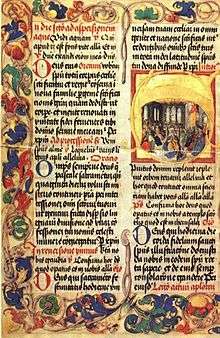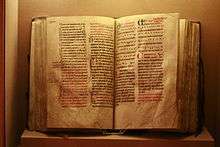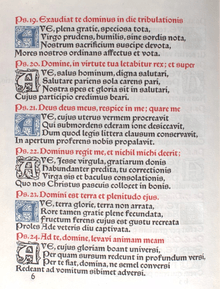Rubric

A rubric is a word or section of text that is traditionally written or printed in red ink for emphasis. The word derives from the Latin: rubrica, meaning red ochre or red chalk,[1] and originates in Medieval illuminated manuscripts from the 13th century or earlier. In these, red letters were used to highlight initial capitals (particularly of psalms), section headings and names of religious significance, a practice known as rubrication, which was a separate stage in the production of a manuscript.
Rubric can also mean the red ink or paint used to make rubrics, or the pigment used to make it.[2] Although red was most often used, other colours came into use from the late Middle Ages onwards, and the word rubric was used for these also.
Various figurative senses of the word have been extended from its original sense. Usually these senses are used within the set phrase "under [whatever] rubric," for example, "under this rubric, [X is true]," or "[X was done] under the rubric of Y." These senses are defined in part by Merriam-Webster's Collegiate[3] as follows: "an authoritative rule"; "the title of a statute"; "something under which a thing is classed : CATEGORY"; "an explanatory or introductory commentary : GLOSS"; "an established rule, tradition, or custom"; "a guide listing specific criteria for grading or scoring academic [assignments] ."[3] (See Merriam-Webster's Collegiate[3] for the full listing.)
Instructions in liturgical contexts
Instructions for a priest explaining what he had to do during a liturgical service were also rubricated in missals and the other forms of service book, leaving the sections to be spoken aloud in black.[4] From this, rubric has a second meaning of an instruction in a text, regardless of how it is written or printed. This is in fact the oldest recorded meaning in English, found in 1375.[5] Less formally, rubrics may refer to any liturgical action customarily performed over the course of a service, whether or not they are actually written down. The history, status and authority of the content of rubrics is a matter of significance, and sometimes controversy, among scholars of liturgy. In the past, some theologians attempted to distinguish between those rubrics they considered of divine origin, and those merely of human origin. Rubrics were probably originally verbal, and then written down in separate volumes. The earliest service books to survive do not contain them, but from references in writings of the first millennium it appears that written versions existed.[6] Full rubrics that cover matters such as vestments to wear, the appearance of the altar, when to hold particular services, and similar matters may still be published separately. In modern service books like the Roman Missal, lengthy general rubrics (probably printed in the normal black) cover such issues, and preface the actual orders of service, which contain shorter basic rubrics for the conduct of the service, still usually printed in red. Red is also often used to distinguish between words spoken by the celebrant and the congregation, or by other specific people involved in a service (people being married, for example).
After the development of printing
With the arrival of printing, other typographic effects such as italic type, or using a bold, or different size type, became used for emphasizing a section of text, and as printing in two colours is more expensive and time-consuming, red rubrics have since tended to be reserved specifically for religious service books, luxury editions, or books where design is emphasized.
William Morris's medieval-inspired typography for the Kelmscott Press at the end of the 19th century included chapter titles and other accents in red (or rarely blue) ink, and was influential on small press art typography associated with the Arts and Crafts movement in both England and the United States, particularly the work of the Ashendene, Doves, and Roycroft presses.[7][8]
Around 1900, red rubrics were incorporated into a Red letter edition of the King James translation of the Bible to distinguish the words spoken by Jesus during his mortal ministry, that translation lacking quotation marks. Other versions of the Bible have since adopted the popular practice.
See also
References
- ↑ OED meaning 1a.
- ↑ OED meaning 1b
- 1 2 3 Merriam-Webster, "headword "rubric"", Merriam-Webster's Collegiate Dictionary (11th ed.), Merriam-Webster.
- ↑ "Rubrics". Catholic Encyclopedia.
- ↑ OED meaning 3
- ↑ Catholic Encyclopedia, article cited
- 1 2 Parry, Linda: William Morris, New York: Harry Abrams, 1996, ISBN 0-8109-4282-8
- ↑ Naylor, Gillian: "The Things That Might Be: British Design after Morris". In Diane Waggoner, ed.: The Beauty of Life: William Morris & the Art of Design, New York: Thames and Hudson, 2003, ISBN 0-500-28434-2, p. 122-124
External links
| Wikimedia Commons has media related to Rubrics. |
- Rubrics of the Anglican Low Mass (from 1931) Very full set of rubrics (more than a normal service book would include); perversely, the words to be spoken are here shown in red, and the rubrics in black.
- Catholic Order of Mass Rubrics showing who speaks are in red; others in small italics.
- Kelmscott Press Examples of Kelmscott Press pages showing use of red accents.
- So this then is the preachment entitled Chicago tongue A "flip book" presentation of the Roycroft Press edition c. 1913, illustrating use of rubrics in the Arts and Crafts tradition.
- Good Recipes This cookbook published by the Woman's Society of the Winnetka Congregational Church in 1906 shows the influence of Arts and Crafts rubrics on everyday typography in the early 20th century.

